To Measure Greenwashing Practices Effect on H&M Brand Image
VerifiedAdded on 2021/02/20
|37
|10257
|25
Report
AI Summary
This report examines the effect of greenwashing practices on the brand image of H&M, a prominent clothing retailer. It begins by establishing the importance of corporate governance and sustainability in modern business, emphasizing how ethical practices and stakeholder relationships contribute to a strong brand image. The report defines greenwashing and highlights how H&M's marketing strategies, such as the World Recycle Week, were perceived as attempts to mislead consumers about the company's environmental impact. It explores the negative consequences of these practices, including damage to brand reputation and potential financial losses. The research incorporates a literature review on corporate governance, sustainability, and greenwashing, followed by a detailed methodology section outlining the research philosophy, design, data sources, and analysis techniques. The findings are presented through a critical review of both secondary and primary research, followed by recommendations and an action plan to improve H&M's brand image and address the negative impacts of greenwashing. The report concludes by summarizing the key findings and emphasizing the importance of ethical and sustainable business practices for long-term success.

To Measure The Effect Of Green-Washing Practices On
Brand Image Of A Company. A Case On H&M
Brand Image Of A Company. A Case On H&M
Paraphrase This Document
Need a fresh take? Get an instant paraphrase of this document with our AI Paraphraser
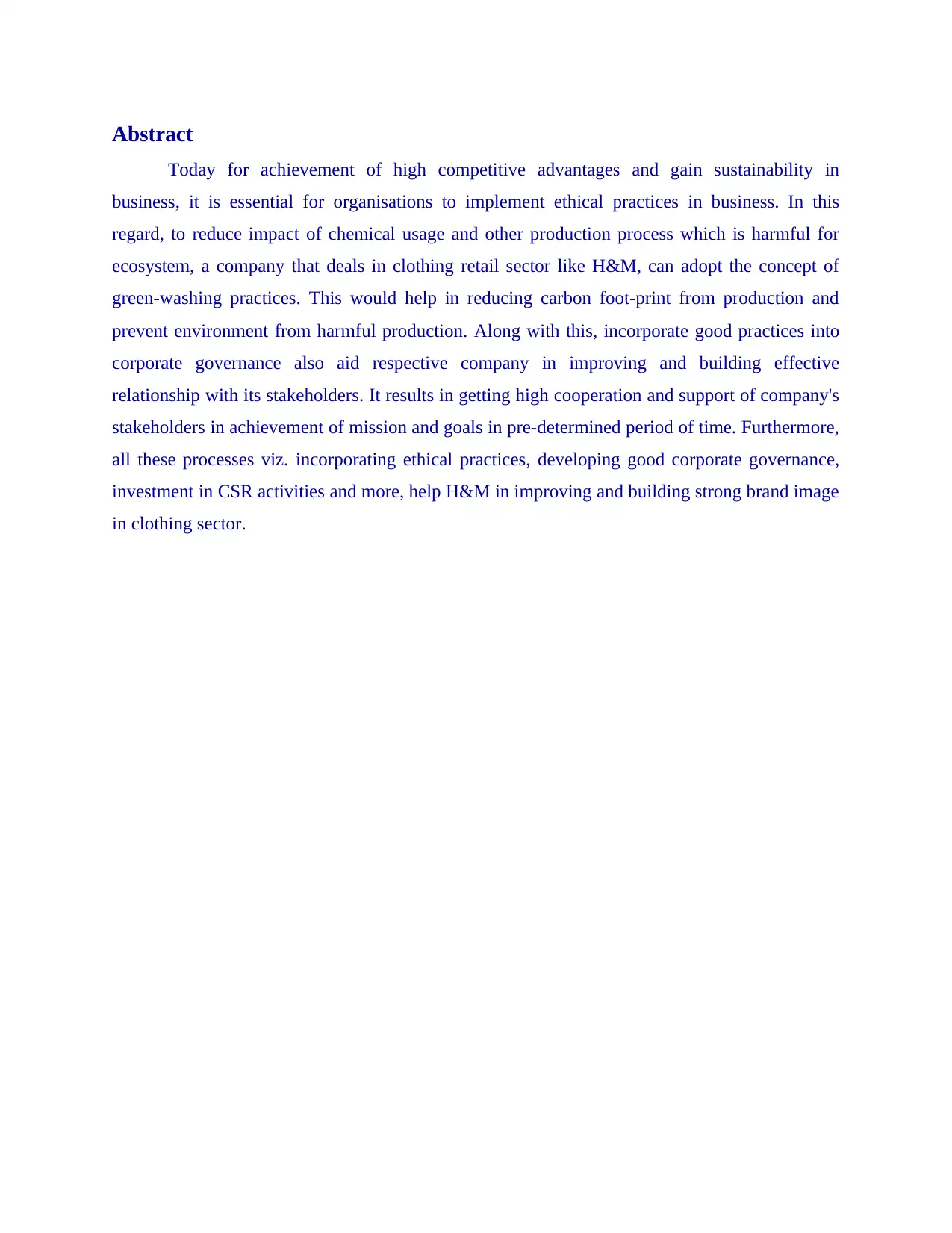
Abstract
Today for achievement of high competitive advantages and gain sustainability in
business, it is essential for organisations to implement ethical practices in business. In this
regard, to reduce impact of chemical usage and other production process which is harmful for
ecosystem, a company that deals in clothing retail sector like H&M, can adopt the concept of
green-washing practices. This would help in reducing carbon foot-print from production and
prevent environment from harmful production. Along with this, incorporate good practices into
corporate governance also aid respective company in improving and building effective
relationship with its stakeholders. It results in getting high cooperation and support of company's
stakeholders in achievement of mission and goals in pre-determined period of time. Furthermore,
all these processes viz. incorporating ethical practices, developing good corporate governance,
investment in CSR activities and more, help H&M in improving and building strong brand image
in clothing sector.
Today for achievement of high competitive advantages and gain sustainability in
business, it is essential for organisations to implement ethical practices in business. In this
regard, to reduce impact of chemical usage and other production process which is harmful for
ecosystem, a company that deals in clothing retail sector like H&M, can adopt the concept of
green-washing practices. This would help in reducing carbon foot-print from production and
prevent environment from harmful production. Along with this, incorporate good practices into
corporate governance also aid respective company in improving and building effective
relationship with its stakeholders. It results in getting high cooperation and support of company's
stakeholders in achievement of mission and goals in pre-determined period of time. Furthermore,
all these processes viz. incorporating ethical practices, developing good corporate governance,
investment in CSR activities and more, help H&M in improving and building strong brand image
in clothing sector.

Table of Contents
To Measure The Effect Of Green-Washing Practices On Brand Image Of A Company. A Case
On H&M..........................................................................................................................................1
Abstract ...........................................................................................................................................2
TOPIC - “To measure the effect of green-washing practices on brand image of a company. A
case on H&M.”................................................................................................................................5
Chapter 1: INTRODUCTION..........................................................................................................5
1.1 Corporate governance & Sustainability............................................................................5
1.2 Background of the problem..............................................................................................5
1.3 Purpose and Significance of the research.........................................................................7
1.4 Research Aim...................................................................................................................7
1.4 Research Objectives.........................................................................................................8
1.5 Research Questions..........................................................................................................8
Chapter 2: Literature Review...........................................................................................................9
2.1 Corporate governance ......................................................................................................9
2.2 Importance of sustainability for a company...................................................................10
2.3 Concept of green-washing..............................................................................................11
2.4 Effectiveness of Green-washing on brand image of a company....................................12
Chapter 3: Research Methodology.................................................................................................14
3.1 Introduction....................................................................................................................14
3.2 Research Philosophy......................................................................................................14
3.3 Research Design.............................................................................................................15
3.4 Logic and approach........................................................................................................15
3.5 Data Sources...................................................................................................................15
3.6 Data collection strategies................................................................................................15
3.7 Population, sampling and sample...................................................................................15
3.8 Data analysis...................................................................................................................16
3.9 Ethics, limitation of research methods...........................................................................16
3.10 Research Instrument.....................................................................................................16
To Measure The Effect Of Green-Washing Practices On Brand Image Of A Company. A Case
On H&M..........................................................................................................................................1
Abstract ...........................................................................................................................................2
TOPIC - “To measure the effect of green-washing practices on brand image of a company. A
case on H&M.”................................................................................................................................5
Chapter 1: INTRODUCTION..........................................................................................................5
1.1 Corporate governance & Sustainability............................................................................5
1.2 Background of the problem..............................................................................................5
1.3 Purpose and Significance of the research.........................................................................7
1.4 Research Aim...................................................................................................................7
1.4 Research Objectives.........................................................................................................8
1.5 Research Questions..........................................................................................................8
Chapter 2: Literature Review...........................................................................................................9
2.1 Corporate governance ......................................................................................................9
2.2 Importance of sustainability for a company...................................................................10
2.3 Concept of green-washing..............................................................................................11
2.4 Effectiveness of Green-washing on brand image of a company....................................12
Chapter 3: Research Methodology.................................................................................................14
3.1 Introduction....................................................................................................................14
3.2 Research Philosophy......................................................................................................14
3.3 Research Design.............................................................................................................15
3.4 Logic and approach........................................................................................................15
3.5 Data Sources...................................................................................................................15
3.6 Data collection strategies................................................................................................15
3.7 Population, sampling and sample...................................................................................15
3.8 Data analysis...................................................................................................................16
3.9 Ethics, limitation of research methods...........................................................................16
3.10 Research Instrument.....................................................................................................16
⊘ This is a preview!⊘
Do you want full access?
Subscribe today to unlock all pages.

Trusted by 1+ million students worldwide
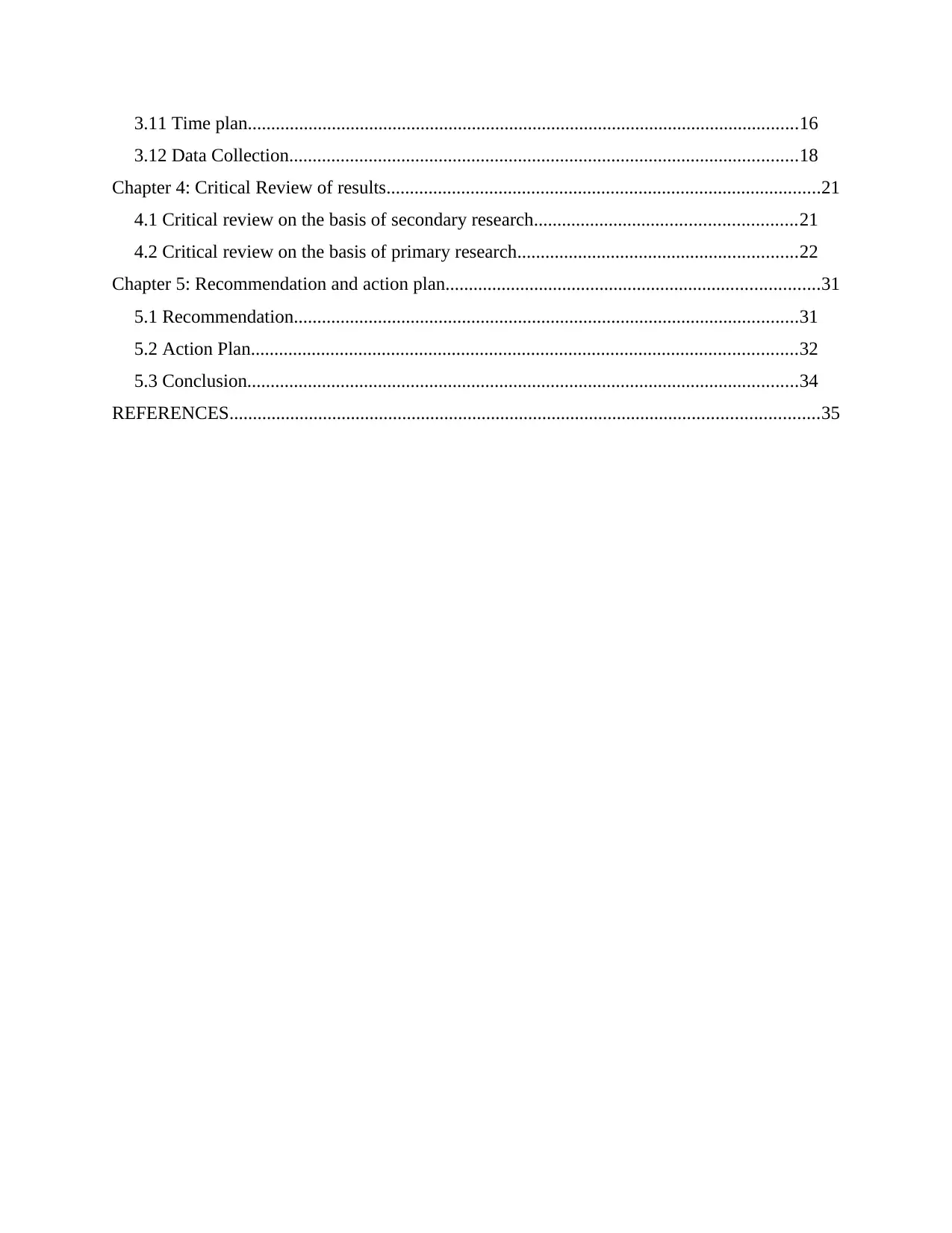
3.11 Time plan......................................................................................................................16
3.12 Data Collection.............................................................................................................18
Chapter 4: Critical Review of results.............................................................................................21
4.1 Critical review on the basis of secondary research........................................................21
4.2 Critical review on the basis of primary research............................................................22
Chapter 5: Recommendation and action plan................................................................................31
5.1 Recommendation............................................................................................................31
5.2 Action Plan.....................................................................................................................32
5.3 Conclusion......................................................................................................................34
REFERENCES..............................................................................................................................35
3.12 Data Collection.............................................................................................................18
Chapter 4: Critical Review of results.............................................................................................21
4.1 Critical review on the basis of secondary research........................................................21
4.2 Critical review on the basis of primary research............................................................22
Chapter 5: Recommendation and action plan................................................................................31
5.1 Recommendation............................................................................................................31
5.2 Action Plan.....................................................................................................................32
5.3 Conclusion......................................................................................................................34
REFERENCES..............................................................................................................................35
Paraphrase This Document
Need a fresh take? Get an instant paraphrase of this document with our AI Paraphraser
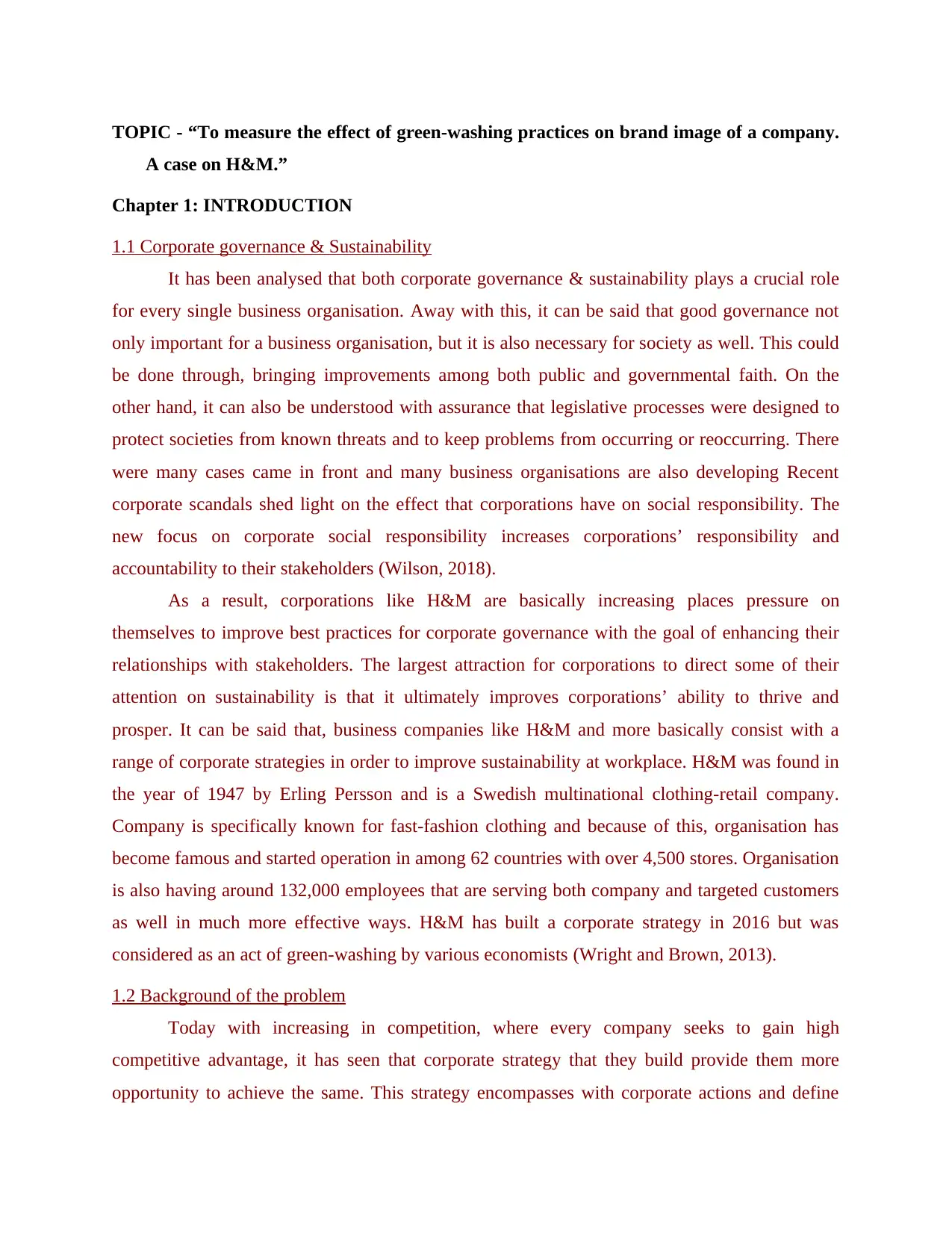
TOPIC - “To measure the effect of green-washing practices on brand image of a company.
A case on H&M.”
Chapter 1: INTRODUCTION
1.1 Corporate governance & Sustainability
It has been analysed that both corporate governance & sustainability plays a crucial role
for every single business organisation. Away with this, it can be said that good governance not
only important for a business organisation, but it is also necessary for society as well. This could
be done through, bringing improvements among both public and governmental faith. On the
other hand, it can also be understood with assurance that legislative processes were designed to
protect societies from known threats and to keep problems from occurring or reoccurring. There
were many cases came in front and many business organisations are also developing Recent
corporate scandals shed light on the effect that corporations have on social responsibility. The
new focus on corporate social responsibility increases corporations’ responsibility and
accountability to their stakeholders (Wilson, 2018).
As a result, corporations like H&M are basically increasing places pressure on
themselves to improve best practices for corporate governance with the goal of enhancing their
relationships with stakeholders. The largest attraction for corporations to direct some of their
attention on sustainability is that it ultimately improves corporations’ ability to thrive and
prosper. It can be said that, business companies like H&M and more basically consist with a
range of corporate strategies in order to improve sustainability at workplace. H&M was found in
the year of 1947 by Erling Persson and is a Swedish multinational clothing-retail company.
Company is specifically known for fast-fashion clothing and because of this, organisation has
become famous and started operation in among 62 countries with over 4,500 stores. Organisation
is also having around 132,000 employees that are serving both company and targeted customers
as well in much more effective ways. H&M has built a corporate strategy in 2016 but was
considered as an act of green-washing by various economists (Wright and Brown, 2013).
1.2 Background of the problem
Today with increasing in competition, where every company seeks to gain high
competitive advantage, it has seen that corporate strategy that they build provide them more
opportunity to achieve the same. This strategy encompasses with corporate actions and define
A case on H&M.”
Chapter 1: INTRODUCTION
1.1 Corporate governance & Sustainability
It has been analysed that both corporate governance & sustainability plays a crucial role
for every single business organisation. Away with this, it can be said that good governance not
only important for a business organisation, but it is also necessary for society as well. This could
be done through, bringing improvements among both public and governmental faith. On the
other hand, it can also be understood with assurance that legislative processes were designed to
protect societies from known threats and to keep problems from occurring or reoccurring. There
were many cases came in front and many business organisations are also developing Recent
corporate scandals shed light on the effect that corporations have on social responsibility. The
new focus on corporate social responsibility increases corporations’ responsibility and
accountability to their stakeholders (Wilson, 2018).
As a result, corporations like H&M are basically increasing places pressure on
themselves to improve best practices for corporate governance with the goal of enhancing their
relationships with stakeholders. The largest attraction for corporations to direct some of their
attention on sustainability is that it ultimately improves corporations’ ability to thrive and
prosper. It can be said that, business companies like H&M and more basically consist with a
range of corporate strategies in order to improve sustainability at workplace. H&M was found in
the year of 1947 by Erling Persson and is a Swedish multinational clothing-retail company.
Company is specifically known for fast-fashion clothing and because of this, organisation has
become famous and started operation in among 62 countries with over 4,500 stores. Organisation
is also having around 132,000 employees that are serving both company and targeted customers
as well in much more effective ways. H&M has built a corporate strategy in 2016 but was
considered as an act of green-washing by various economists (Wright and Brown, 2013).
1.2 Background of the problem
Today with increasing in competition, where every company seeks to gain high
competitive advantage, it has seen that corporate strategy that they build provide them more
opportunity to achieve the same. This strategy encompasses with corporate actions and define
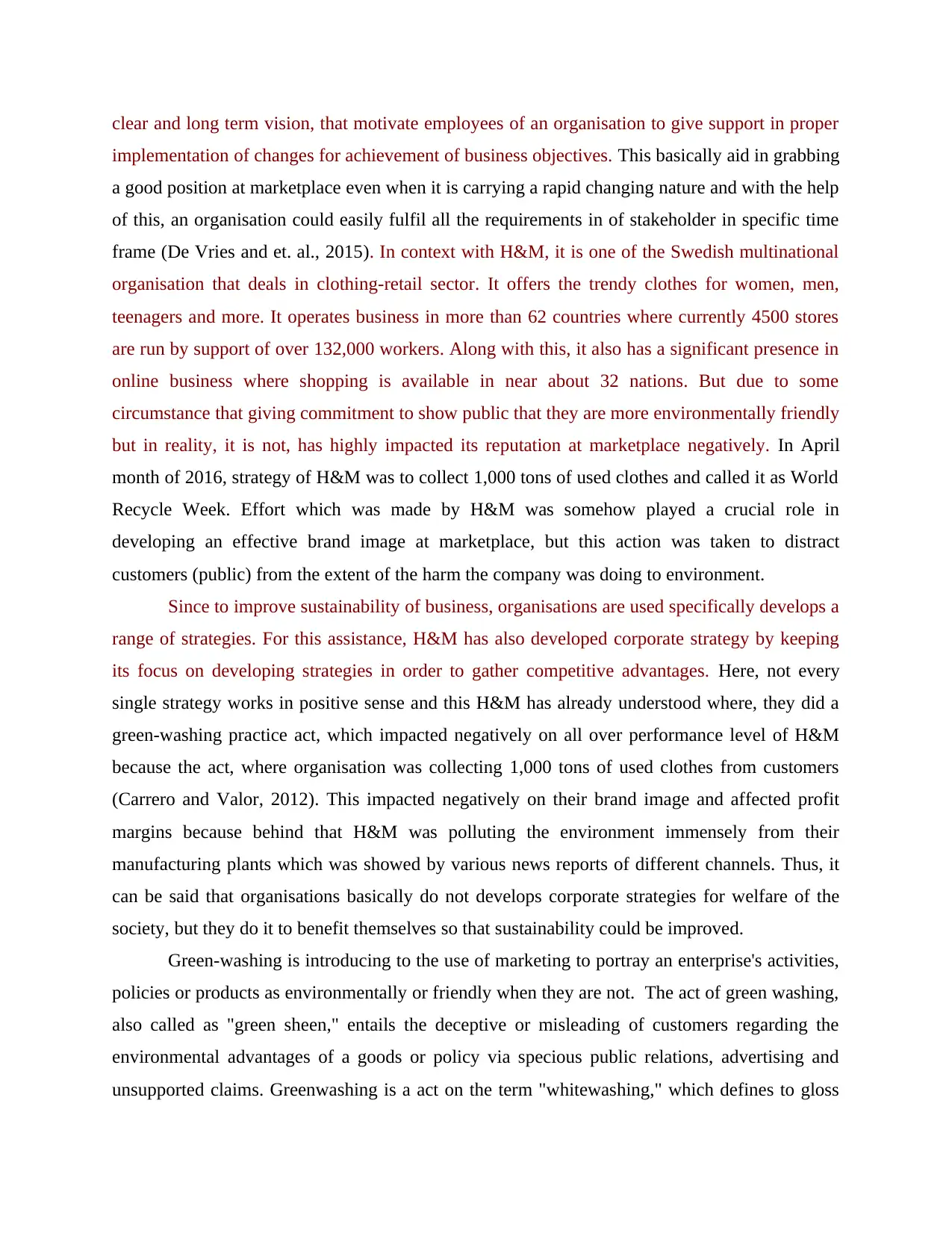
clear and long term vision, that motivate employees of an organisation to give support in proper
implementation of changes for achievement of business objectives. This basically aid in grabbing
a good position at marketplace even when it is carrying a rapid changing nature and with the help
of this, an organisation could easily fulfil all the requirements in of stakeholder in specific time
frame (De Vries and et. al., 2015). In context with H&M, it is one of the Swedish multinational
organisation that deals in clothing-retail sector. It offers the trendy clothes for women, men,
teenagers and more. It operates business in more than 62 countries where currently 4500 stores
are run by support of over 132,000 workers. Along with this, it also has a significant presence in
online business where shopping is available in near about 32 nations. But due to some
circumstance that giving commitment to show public that they are more environmentally friendly
but in reality, it is not, has highly impacted its reputation at marketplace negatively. In April
month of 2016, strategy of H&M was to collect 1,000 tons of used clothes and called it as World
Recycle Week. Effort which was made by H&M was somehow played a crucial role in
developing an effective brand image at marketplace, but this action was taken to distract
customers (public) from the extent of the harm the company was doing to environment.
Since to improve sustainability of business, organisations are used specifically develops a
range of strategies. For this assistance, H&M has also developed corporate strategy by keeping
its focus on developing strategies in order to gather competitive advantages. Here, not every
single strategy works in positive sense and this H&M has already understood where, they did a
green-washing practice act, which impacted negatively on all over performance level of H&M
because the act, where organisation was collecting 1,000 tons of used clothes from customers
(Carrero and Valor, 2012). This impacted negatively on their brand image and affected profit
margins because behind that H&M was polluting the environment immensely from their
manufacturing plants which was showed by various news reports of different channels. Thus, it
can be said that organisations basically do not develops corporate strategies for welfare of the
society, but they do it to benefit themselves so that sustainability could be improved.
Green-washing is introducing to the use of marketing to portray an enterprise's activities,
policies or products as environmentally or friendly when they are not. The act of green washing,
also called as "green sheen," entails the deceptive or misleading of customers regarding the
environmental advantages of a goods or policy via specious public relations, advertising and
unsupported claims. Greenwashing is a act on the term "whitewashing," which defines to gloss
implementation of changes for achievement of business objectives. This basically aid in grabbing
a good position at marketplace even when it is carrying a rapid changing nature and with the help
of this, an organisation could easily fulfil all the requirements in of stakeholder in specific time
frame (De Vries and et. al., 2015). In context with H&M, it is one of the Swedish multinational
organisation that deals in clothing-retail sector. It offers the trendy clothes for women, men,
teenagers and more. It operates business in more than 62 countries where currently 4500 stores
are run by support of over 132,000 workers. Along with this, it also has a significant presence in
online business where shopping is available in near about 32 nations. But due to some
circumstance that giving commitment to show public that they are more environmentally friendly
but in reality, it is not, has highly impacted its reputation at marketplace negatively. In April
month of 2016, strategy of H&M was to collect 1,000 tons of used clothes and called it as World
Recycle Week. Effort which was made by H&M was somehow played a crucial role in
developing an effective brand image at marketplace, but this action was taken to distract
customers (public) from the extent of the harm the company was doing to environment.
Since to improve sustainability of business, organisations are used specifically develops a
range of strategies. For this assistance, H&M has also developed corporate strategy by keeping
its focus on developing strategies in order to gather competitive advantages. Here, not every
single strategy works in positive sense and this H&M has already understood where, they did a
green-washing practice act, which impacted negatively on all over performance level of H&M
because the act, where organisation was collecting 1,000 tons of used clothes from customers
(Carrero and Valor, 2012). This impacted negatively on their brand image and affected profit
margins because behind that H&M was polluting the environment immensely from their
manufacturing plants which was showed by various news reports of different channels. Thus, it
can be said that organisations basically do not develops corporate strategies for welfare of the
society, but they do it to benefit themselves so that sustainability could be improved.
Green-washing is introducing to the use of marketing to portray an enterprise's activities,
policies or products as environmentally or friendly when they are not. The act of green washing,
also called as "green sheen," entails the deceptive or misleading of customers regarding the
environmental advantages of a goods or policy via specious public relations, advertising and
unsupported claims. Greenwashing is a act on the term "whitewashing," which defines to gloss
⊘ This is a preview!⊘
Do you want full access?
Subscribe today to unlock all pages.

Trusted by 1+ million students worldwide
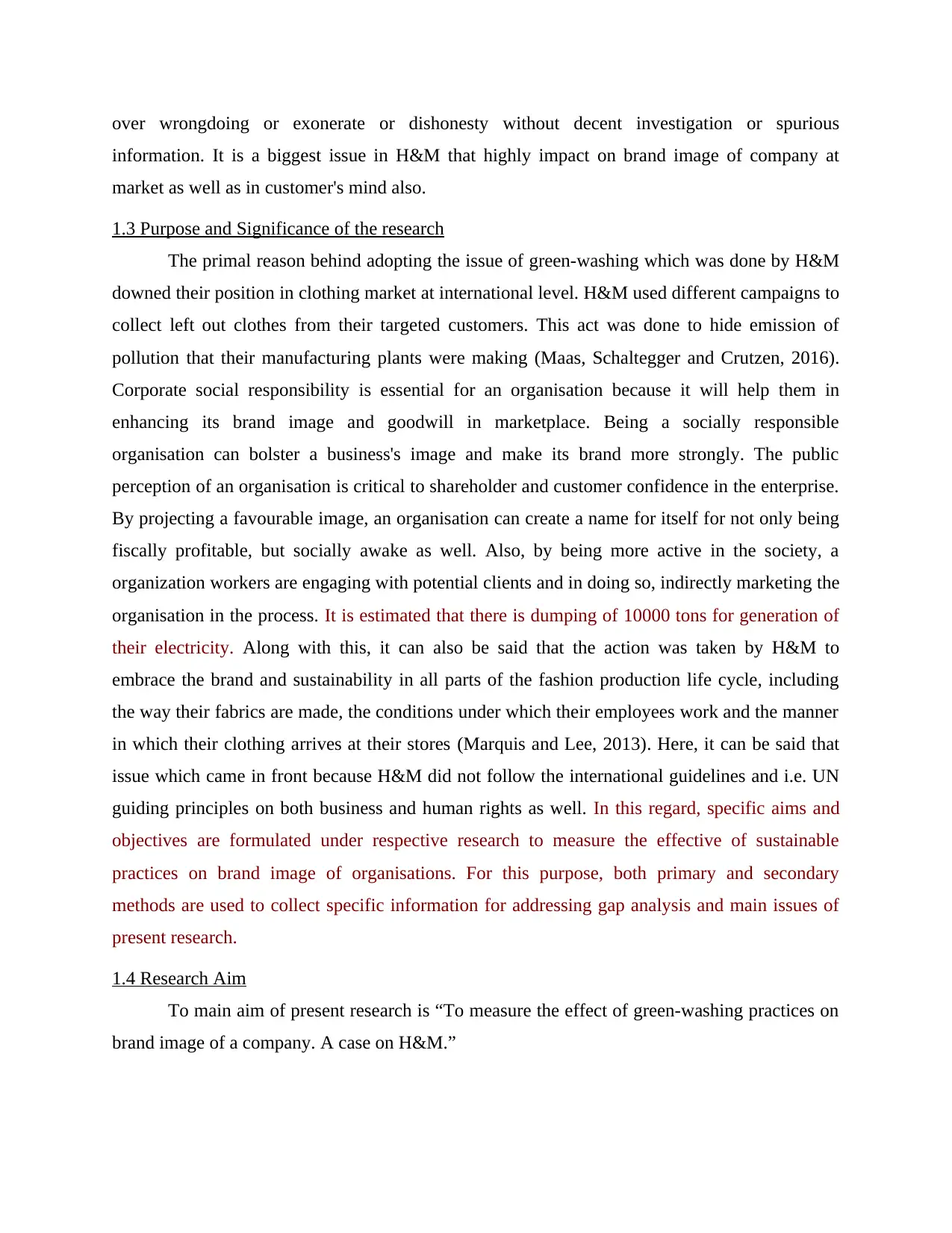
over wrongdoing or exonerate or dishonesty without decent investigation or spurious
information. It is a biggest issue in H&M that highly impact on brand image of company at
market as well as in customer's mind also.
1.3 Purpose and Significance of the research
The primal reason behind adopting the issue of green-washing which was done by H&M
downed their position in clothing market at international level. H&M used different campaigns to
collect left out clothes from their targeted customers. This act was done to hide emission of
pollution that their manufacturing plants were making (Maas, Schaltegger and Crutzen, 2016).
Corporate social responsibility is essential for an organisation because it will help them in
enhancing its brand image and goodwill in marketplace. Being a socially responsible
organisation can bolster a business's image and make its brand more strongly. The public
perception of an organisation is critical to shareholder and customer confidence in the enterprise.
By projecting a favourable image, an organisation can create a name for itself for not only being
fiscally profitable, but socially awake as well. Also, by being more active in the society, a
organization workers are engaging with potential clients and in doing so, indirectly marketing the
organisation in the process. It is estimated that there is dumping of 10000 tons for generation of
their electricity. Along with this, it can also be said that the action was taken by H&M to
embrace the brand and sustainability in all parts of the fashion production life cycle, including
the way their fabrics are made, the conditions under which their employees work and the manner
in which their clothing arrives at their stores (Marquis and Lee, 2013). Here, it can be said that
issue which came in front because H&M did not follow the international guidelines and i.e. UN
guiding principles on both business and human rights as well. In this regard, specific aims and
objectives are formulated under respective research to measure the effective of sustainable
practices on brand image of organisations. For this purpose, both primary and secondary
methods are used to collect specific information for addressing gap analysis and main issues of
present research.
1.4 Research Aim
To main aim of present research is “To measure the effect of green-washing practices on
brand image of a company. A case on H&M.”
information. It is a biggest issue in H&M that highly impact on brand image of company at
market as well as in customer's mind also.
1.3 Purpose and Significance of the research
The primal reason behind adopting the issue of green-washing which was done by H&M
downed their position in clothing market at international level. H&M used different campaigns to
collect left out clothes from their targeted customers. This act was done to hide emission of
pollution that their manufacturing plants were making (Maas, Schaltegger and Crutzen, 2016).
Corporate social responsibility is essential for an organisation because it will help them in
enhancing its brand image and goodwill in marketplace. Being a socially responsible
organisation can bolster a business's image and make its brand more strongly. The public
perception of an organisation is critical to shareholder and customer confidence in the enterprise.
By projecting a favourable image, an organisation can create a name for itself for not only being
fiscally profitable, but socially awake as well. Also, by being more active in the society, a
organization workers are engaging with potential clients and in doing so, indirectly marketing the
organisation in the process. It is estimated that there is dumping of 10000 tons for generation of
their electricity. Along with this, it can also be said that the action was taken by H&M to
embrace the brand and sustainability in all parts of the fashion production life cycle, including
the way their fabrics are made, the conditions under which their employees work and the manner
in which their clothing arrives at their stores (Marquis and Lee, 2013). Here, it can be said that
issue which came in front because H&M did not follow the international guidelines and i.e. UN
guiding principles on both business and human rights as well. In this regard, specific aims and
objectives are formulated under respective research to measure the effective of sustainable
practices on brand image of organisations. For this purpose, both primary and secondary
methods are used to collect specific information for addressing gap analysis and main issues of
present research.
1.4 Research Aim
To main aim of present research is “To measure the effect of green-washing practices on
brand image of a company. A case on H&M.”
Paraphrase This Document
Need a fresh take? Get an instant paraphrase of this document with our AI Paraphraser

1.4 Research Objectives
To understand the concept of corporate governance.
To analyse the relationship between green-washing practices and sustainability.
To measure the effect of green-washing practices on brand image of a company.
1.5 Research Questions
What is corporate governance?
How green-washing practices of a company leads towards sustainability?
How green-washing practices effect the brand image of a company?
To understand the concept of corporate governance.
To analyse the relationship between green-washing practices and sustainability.
To measure the effect of green-washing practices on brand image of a company.
1.5 Research Questions
What is corporate governance?
How green-washing practices of a company leads towards sustainability?
How green-washing practices effect the brand image of a company?
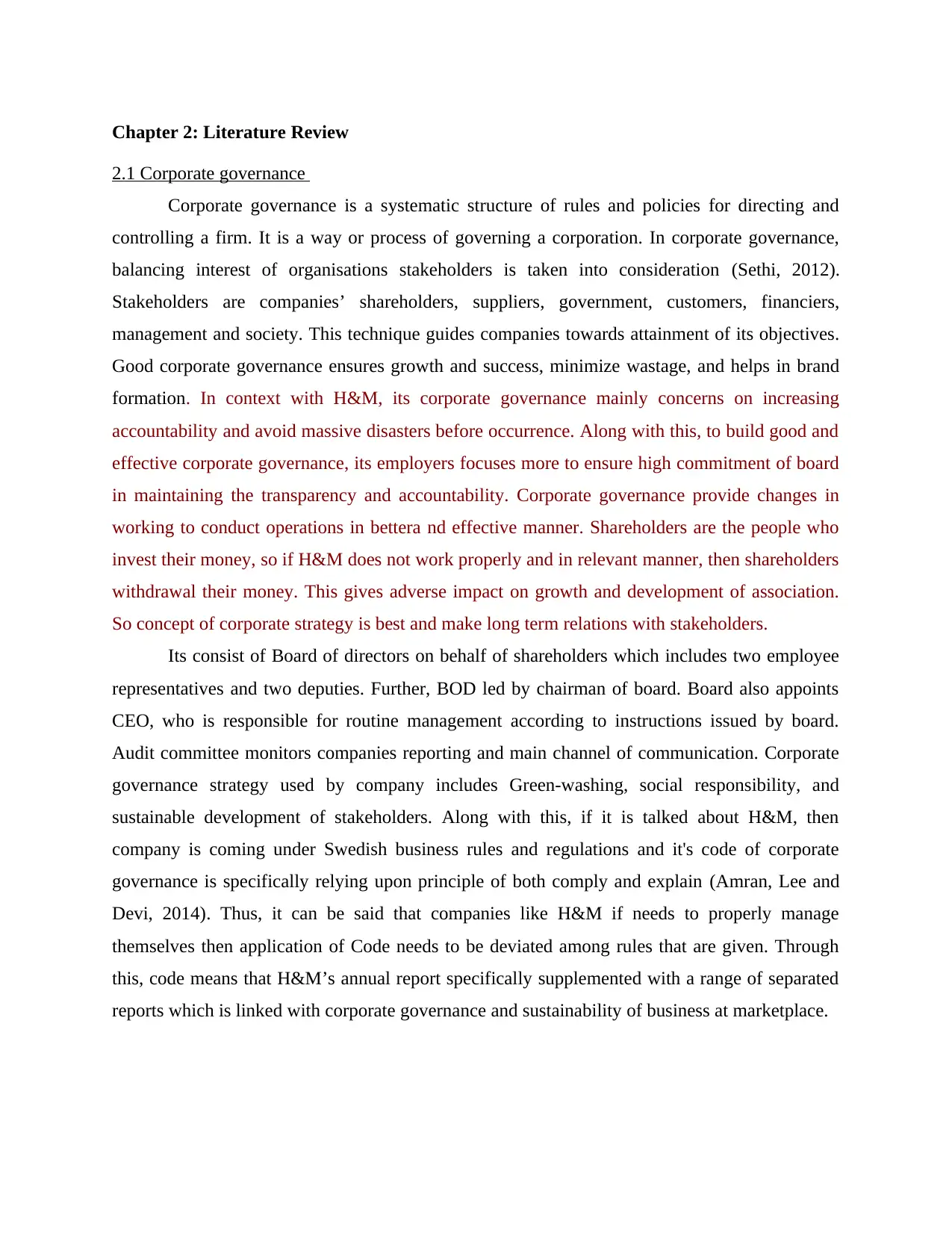
Chapter 2: Literature Review
2.1 Corporate governance
Corporate governance is a systematic structure of rules and policies for directing and
controlling a firm. It is a way or process of governing a corporation. In corporate governance,
balancing interest of organisations stakeholders is taken into consideration (Sethi, 2012).
Stakeholders are companies’ shareholders, suppliers, government, customers, financiers,
management and society. This technique guides companies towards attainment of its objectives.
Good corporate governance ensures growth and success, minimize wastage, and helps in brand
formation. In context with H&M, its corporate governance mainly concerns on increasing
accountability and avoid massive disasters before occurrence. Along with this, to build good and
effective corporate governance, its employers focuses more to ensure high commitment of board
in maintaining the transparency and accountability. Corporate governance provide changes in
working to conduct operations in bettera nd effective manner. Shareholders are the people who
invest their money, so if H&M does not work properly and in relevant manner, then shareholders
withdrawal their money. This gives adverse impact on growth and development of association.
So concept of corporate strategy is best and make long term relations with stakeholders.
Its consist of Board of directors on behalf of shareholders which includes two employee
representatives and two deputies. Further, BOD led by chairman of board. Board also appoints
CEO, who is responsible for routine management according to instructions issued by board.
Audit committee monitors companies reporting and main channel of communication. Corporate
governance strategy used by company includes Green-washing, social responsibility, and
sustainable development of stakeholders. Along with this, if it is talked about H&M, then
company is coming under Swedish business rules and regulations and it's code of corporate
governance is specifically relying upon principle of both comply and explain (Amran, Lee and
Devi, 2014). Thus, it can be said that companies like H&M if needs to properly manage
themselves then application of Code needs to be deviated among rules that are given. Through
this, code means that H&M’s annual report specifically supplemented with a range of separated
reports which is linked with corporate governance and sustainability of business at marketplace.
2.1 Corporate governance
Corporate governance is a systematic structure of rules and policies for directing and
controlling a firm. It is a way or process of governing a corporation. In corporate governance,
balancing interest of organisations stakeholders is taken into consideration (Sethi, 2012).
Stakeholders are companies’ shareholders, suppliers, government, customers, financiers,
management and society. This technique guides companies towards attainment of its objectives.
Good corporate governance ensures growth and success, minimize wastage, and helps in brand
formation. In context with H&M, its corporate governance mainly concerns on increasing
accountability and avoid massive disasters before occurrence. Along with this, to build good and
effective corporate governance, its employers focuses more to ensure high commitment of board
in maintaining the transparency and accountability. Corporate governance provide changes in
working to conduct operations in bettera nd effective manner. Shareholders are the people who
invest their money, so if H&M does not work properly and in relevant manner, then shareholders
withdrawal their money. This gives adverse impact on growth and development of association.
So concept of corporate strategy is best and make long term relations with stakeholders.
Its consist of Board of directors on behalf of shareholders which includes two employee
representatives and two deputies. Further, BOD led by chairman of board. Board also appoints
CEO, who is responsible for routine management according to instructions issued by board.
Audit committee monitors companies reporting and main channel of communication. Corporate
governance strategy used by company includes Green-washing, social responsibility, and
sustainable development of stakeholders. Along with this, if it is talked about H&M, then
company is coming under Swedish business rules and regulations and it's code of corporate
governance is specifically relying upon principle of both comply and explain (Amran, Lee and
Devi, 2014). Thus, it can be said that companies like H&M if needs to properly manage
themselves then application of Code needs to be deviated among rules that are given. Through
this, code means that H&M’s annual report specifically supplemented with a range of separated
reports which is linked with corporate governance and sustainability of business at marketplace.
⊘ This is a preview!⊘
Do you want full access?
Subscribe today to unlock all pages.

Trusted by 1+ million students worldwide
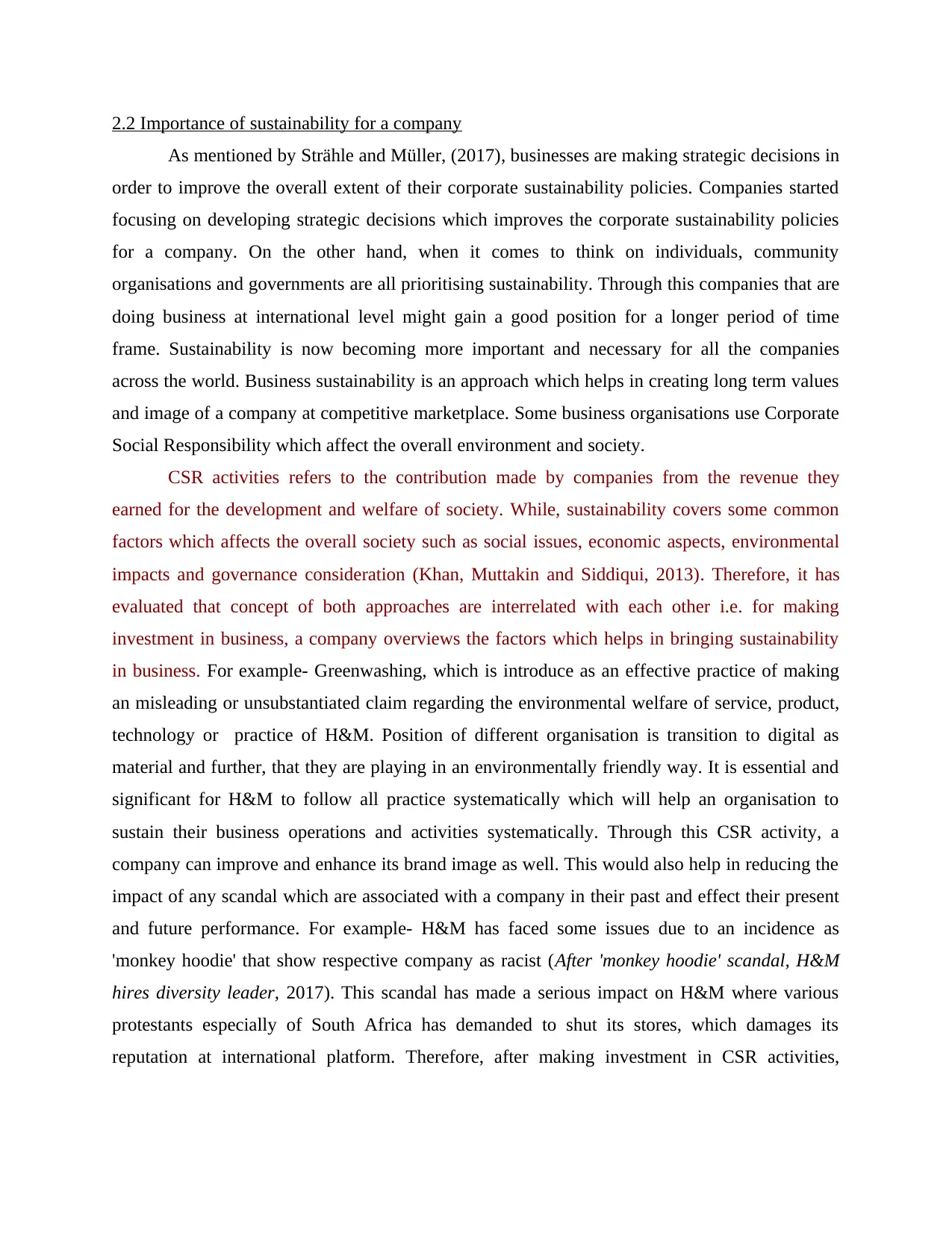
2.2 Importance of sustainability for a company
As mentioned by Strähle and Müller, (2017), businesses are making strategic decisions in
order to improve the overall extent of their corporate sustainability policies. Companies started
focusing on developing strategic decisions which improves the corporate sustainability policies
for a company. On the other hand, when it comes to think on individuals, community
organisations and governments are all prioritising sustainability. Through this companies that are
doing business at international level might gain a good position for a longer period of time
frame. Sustainability is now becoming more important and necessary for all the companies
across the world. Business sustainability is an approach which helps in creating long term values
and image of a company at competitive marketplace. Some business organisations use Corporate
Social Responsibility which affect the overall environment and society.
CSR activities refers to the contribution made by companies from the revenue they
earned for the development and welfare of society. While, sustainability covers some common
factors which affects the overall society such as social issues, economic aspects, environmental
impacts and governance consideration (Khan, Muttakin and Siddiqui, 2013). Therefore, it has
evaluated that concept of both approaches are interrelated with each other i.e. for making
investment in business, a company overviews the factors which helps in bringing sustainability
in business. For example- Greenwashing, which is introduce as an effective practice of making
an misleading or unsubstantiated claim regarding the environmental welfare of service, product,
technology or practice of H&M. Position of different organisation is transition to digital as
material and further, that they are playing in an environmentally friendly way. It is essential and
significant for H&M to follow all practice systematically which will help an organisation to
sustain their business operations and activities systematically. Through this CSR activity, a
company can improve and enhance its brand image as well. This would also help in reducing the
impact of any scandal which are associated with a company in their past and effect their present
and future performance. For example- H&M has faced some issues due to an incidence as
'monkey hoodie' that show respective company as racist (After 'monkey hoodie' scandal, H&M
hires diversity leader, 2017). This scandal has made a serious impact on H&M where various
protestants especially of South Africa has demanded to shut its stores, which damages its
reputation at international platform. Therefore, after making investment in CSR activities,
As mentioned by Strähle and Müller, (2017), businesses are making strategic decisions in
order to improve the overall extent of their corporate sustainability policies. Companies started
focusing on developing strategic decisions which improves the corporate sustainability policies
for a company. On the other hand, when it comes to think on individuals, community
organisations and governments are all prioritising sustainability. Through this companies that are
doing business at international level might gain a good position for a longer period of time
frame. Sustainability is now becoming more important and necessary for all the companies
across the world. Business sustainability is an approach which helps in creating long term values
and image of a company at competitive marketplace. Some business organisations use Corporate
Social Responsibility which affect the overall environment and society.
CSR activities refers to the contribution made by companies from the revenue they
earned for the development and welfare of society. While, sustainability covers some common
factors which affects the overall society such as social issues, economic aspects, environmental
impacts and governance consideration (Khan, Muttakin and Siddiqui, 2013). Therefore, it has
evaluated that concept of both approaches are interrelated with each other i.e. for making
investment in business, a company overviews the factors which helps in bringing sustainability
in business. For example- Greenwashing, which is introduce as an effective practice of making
an misleading or unsubstantiated claim regarding the environmental welfare of service, product,
technology or practice of H&M. Position of different organisation is transition to digital as
material and further, that they are playing in an environmentally friendly way. It is essential and
significant for H&M to follow all practice systematically which will help an organisation to
sustain their business operations and activities systematically. Through this CSR activity, a
company can improve and enhance its brand image as well. This would also help in reducing the
impact of any scandal which are associated with a company in their past and effect their present
and future performance. For example- H&M has faced some issues due to an incidence as
'monkey hoodie' that show respective company as racist (After 'monkey hoodie' scandal, H&M
hires diversity leader, 2017). This scandal has made a serious impact on H&M where various
protestants especially of South Africa has demanded to shut its stores, which damages its
reputation at international platform. Therefore, after making investment in CSR activities,
Paraphrase This Document
Need a fresh take? Get an instant paraphrase of this document with our AI Paraphraser
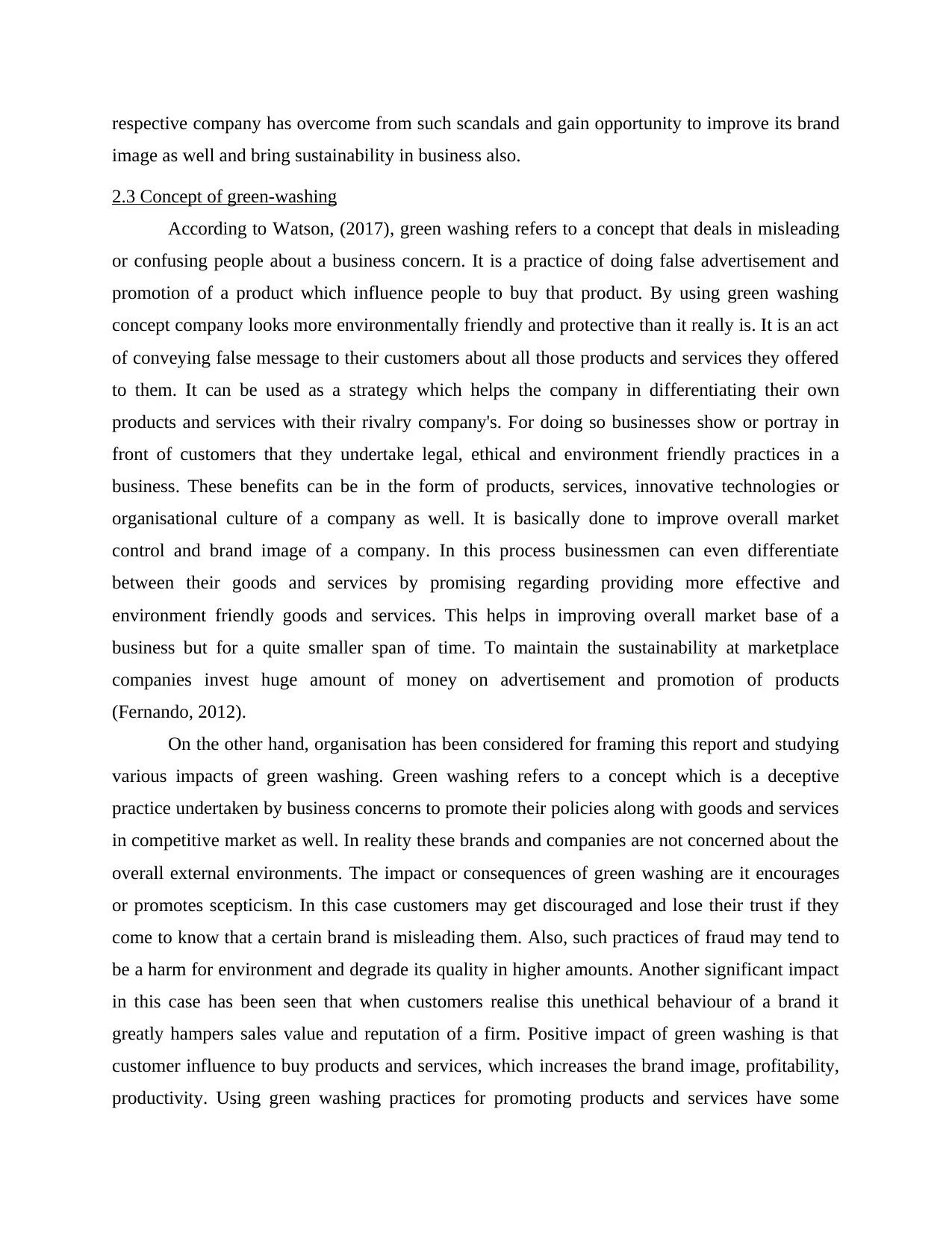
respective company has overcome from such scandals and gain opportunity to improve its brand
image as well and bring sustainability in business also.
2.3 Concept of green-washing
According to Watson, (2017), green washing refers to a concept that deals in misleading
or confusing people about a business concern. It is a practice of doing false advertisement and
promotion of a product which influence people to buy that product. By using green washing
concept company looks more environmentally friendly and protective than it really is. It is an act
of conveying false message to their customers about all those products and services they offered
to them. It can be used as a strategy which helps the company in differentiating their own
products and services with their rivalry company's. For doing so businesses show or portray in
front of customers that they undertake legal, ethical and environment friendly practices in a
business. These benefits can be in the form of products, services, innovative technologies or
organisational culture of a company as well. It is basically done to improve overall market
control and brand image of a company. In this process businessmen can even differentiate
between their goods and services by promising regarding providing more effective and
environment friendly goods and services. This helps in improving overall market base of a
business but for a quite smaller span of time. To maintain the sustainability at marketplace
companies invest huge amount of money on advertisement and promotion of products
(Fernando, 2012).
On the other hand, organisation has been considered for framing this report and studying
various impacts of green washing. Green washing refers to a concept which is a deceptive
practice undertaken by business concerns to promote their policies along with goods and services
in competitive market as well. In reality these brands and companies are not concerned about the
overall external environments. The impact or consequences of green washing are it encourages
or promotes scepticism. In this case customers may get discouraged and lose their trust if they
come to know that a certain brand is misleading them. Also, such practices of fraud may tend to
be a harm for environment and degrade its quality in higher amounts. Another significant impact
in this case has been seen that when customers realise this unethical behaviour of a brand it
greatly hampers sales value and reputation of a firm. Positive impact of green washing is that
customer influence to buy products and services, which increases the brand image, profitability,
productivity. Using green washing practices for promoting products and services have some
image as well and bring sustainability in business also.
2.3 Concept of green-washing
According to Watson, (2017), green washing refers to a concept that deals in misleading
or confusing people about a business concern. It is a practice of doing false advertisement and
promotion of a product which influence people to buy that product. By using green washing
concept company looks more environmentally friendly and protective than it really is. It is an act
of conveying false message to their customers about all those products and services they offered
to them. It can be used as a strategy which helps the company in differentiating their own
products and services with their rivalry company's. For doing so businesses show or portray in
front of customers that they undertake legal, ethical and environment friendly practices in a
business. These benefits can be in the form of products, services, innovative technologies or
organisational culture of a company as well. It is basically done to improve overall market
control and brand image of a company. In this process businessmen can even differentiate
between their goods and services by promising regarding providing more effective and
environment friendly goods and services. This helps in improving overall market base of a
business but for a quite smaller span of time. To maintain the sustainability at marketplace
companies invest huge amount of money on advertisement and promotion of products
(Fernando, 2012).
On the other hand, organisation has been considered for framing this report and studying
various impacts of green washing. Green washing refers to a concept which is a deceptive
practice undertaken by business concerns to promote their policies along with goods and services
in competitive market as well. In reality these brands and companies are not concerned about the
overall external environments. The impact or consequences of green washing are it encourages
or promotes scepticism. In this case customers may get discouraged and lose their trust if they
come to know that a certain brand is misleading them. Also, such practices of fraud may tend to
be a harm for environment and degrade its quality in higher amounts. Another significant impact
in this case has been seen that when customers realise this unethical behaviour of a brand it
greatly hampers sales value and reputation of a firm. Positive impact of green washing is that
customer influence to buy products and services, which increases the brand image, profitability,
productivity. Using green washing practices for promoting products and services have some
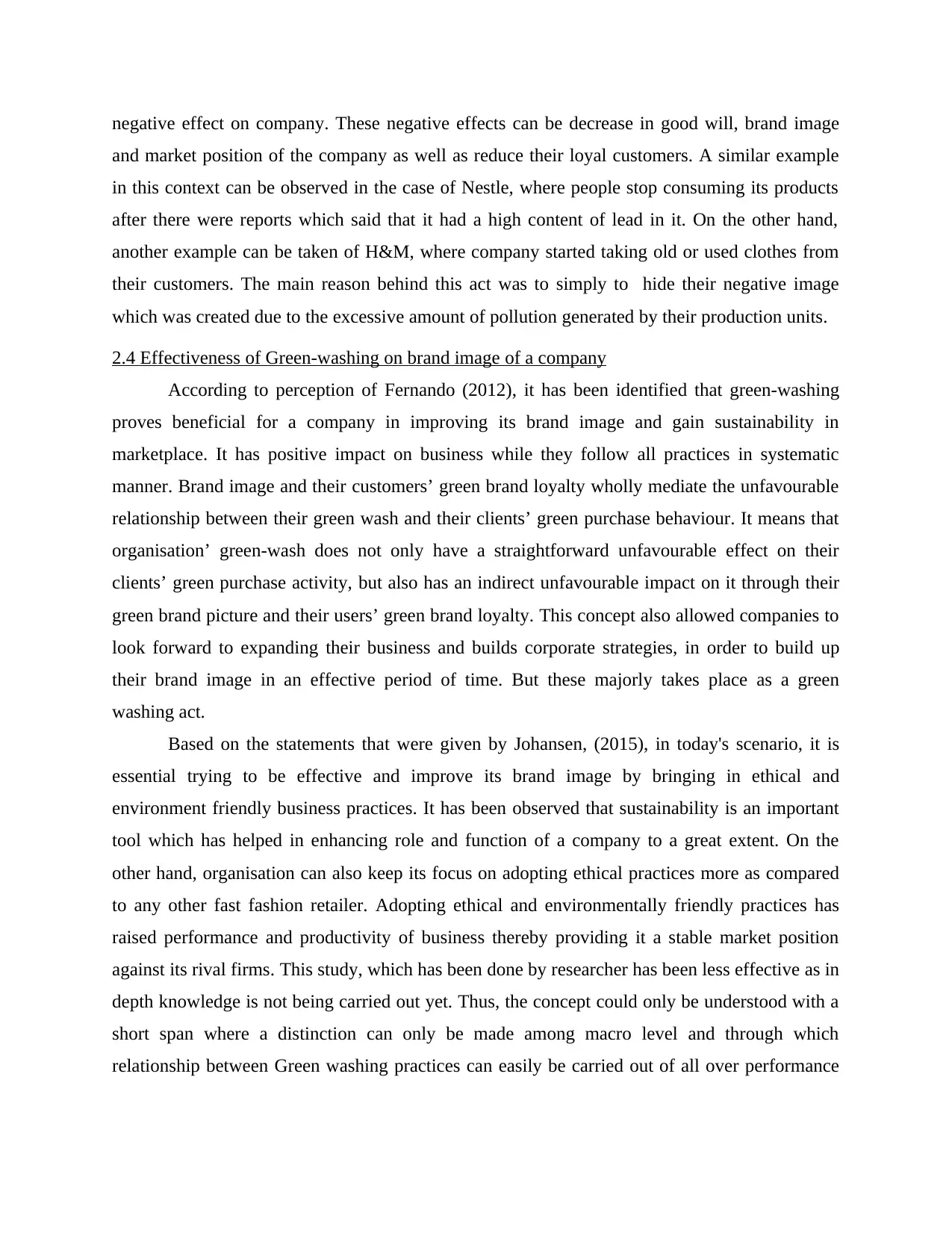
negative effect on company. These negative effects can be decrease in good will, brand image
and market position of the company as well as reduce their loyal customers. A similar example
in this context can be observed in the case of Nestle, where people stop consuming its products
after there were reports which said that it had a high content of lead in it. On the other hand,
another example can be taken of H&M, where company started taking old or used clothes from
their customers. The main reason behind this act was to simply to hide their negative image
which was created due to the excessive amount of pollution generated by their production units.
2.4 Effectiveness of Green-washing on brand image of a company
According to perception of Fernando (2012), it has been identified that green-washing
proves beneficial for a company in improving its brand image and gain sustainability in
marketplace. It has positive impact on business while they follow all practices in systematic
manner. Brand image and their customers’ green brand loyalty wholly mediate the unfavourable
relationship between their green wash and their clients’ green purchase behaviour. It means that
organisation’ green-wash does not only have a straightforward unfavourable effect on their
clients’ green purchase activity, but also has an indirect unfavourable impact on it through their
green brand picture and their users’ green brand loyalty. This concept also allowed companies to
look forward to expanding their business and builds corporate strategies, in order to build up
their brand image in an effective period of time. But these majorly takes place as a green
washing act.
Based on the statements that were given by Johansen, (2015), in today's scenario, it is
essential trying to be effective and improve its brand image by bringing in ethical and
environment friendly business practices. It has been observed that sustainability is an important
tool which has helped in enhancing role and function of a company to a great extent. On the
other hand, organisation can also keep its focus on adopting ethical practices more as compared
to any other fast fashion retailer. Adopting ethical and environmentally friendly practices has
raised performance and productivity of business thereby providing it a stable market position
against its rival firms. This study, which has been done by researcher has been less effective as in
depth knowledge is not being carried out yet. Thus, the concept could only be understood with a
short span where a distinction can only be made among macro level and through which
relationship between Green washing practices can easily be carried out of all over performance
and market position of the company as well as reduce their loyal customers. A similar example
in this context can be observed in the case of Nestle, where people stop consuming its products
after there were reports which said that it had a high content of lead in it. On the other hand,
another example can be taken of H&M, where company started taking old or used clothes from
their customers. The main reason behind this act was to simply to hide their negative image
which was created due to the excessive amount of pollution generated by their production units.
2.4 Effectiveness of Green-washing on brand image of a company
According to perception of Fernando (2012), it has been identified that green-washing
proves beneficial for a company in improving its brand image and gain sustainability in
marketplace. It has positive impact on business while they follow all practices in systematic
manner. Brand image and their customers’ green brand loyalty wholly mediate the unfavourable
relationship between their green wash and their clients’ green purchase behaviour. It means that
organisation’ green-wash does not only have a straightforward unfavourable effect on their
clients’ green purchase activity, but also has an indirect unfavourable impact on it through their
green brand picture and their users’ green brand loyalty. This concept also allowed companies to
look forward to expanding their business and builds corporate strategies, in order to build up
their brand image in an effective period of time. But these majorly takes place as a green
washing act.
Based on the statements that were given by Johansen, (2015), in today's scenario, it is
essential trying to be effective and improve its brand image by bringing in ethical and
environment friendly business practices. It has been observed that sustainability is an important
tool which has helped in enhancing role and function of a company to a great extent. On the
other hand, organisation can also keep its focus on adopting ethical practices more as compared
to any other fast fashion retailer. Adopting ethical and environmentally friendly practices has
raised performance and productivity of business thereby providing it a stable market position
against its rival firms. This study, which has been done by researcher has been less effective as in
depth knowledge is not being carried out yet. Thus, the concept could only be understood with a
short span where a distinction can only be made among macro level and through which
relationship between Green washing practices can easily be carried out of all over performance
⊘ This is a preview!⊘
Do you want full access?
Subscribe today to unlock all pages.

Trusted by 1+ million students worldwide
1 out of 37
Related Documents
Your All-in-One AI-Powered Toolkit for Academic Success.
+13062052269
info@desklib.com
Available 24*7 on WhatsApp / Email
![[object Object]](/_next/static/media/star-bottom.7253800d.svg)
Unlock your academic potential
Copyright © 2020–2025 A2Z Services. All Rights Reserved. Developed and managed by ZUCOL.





